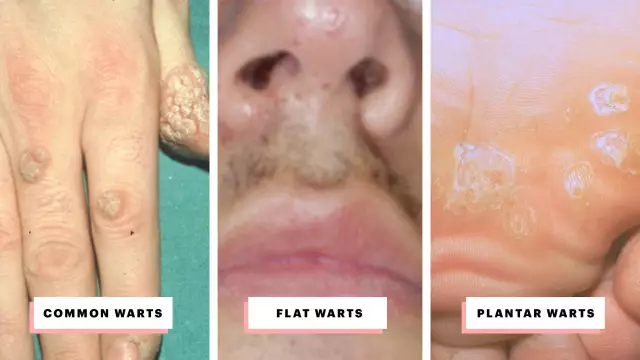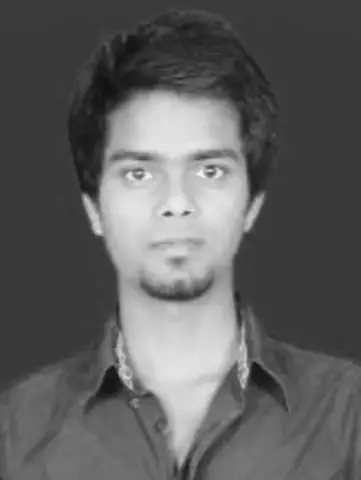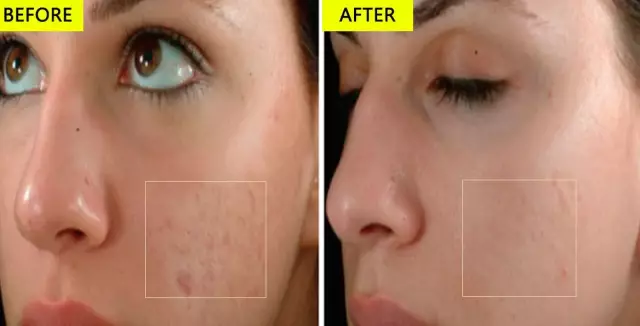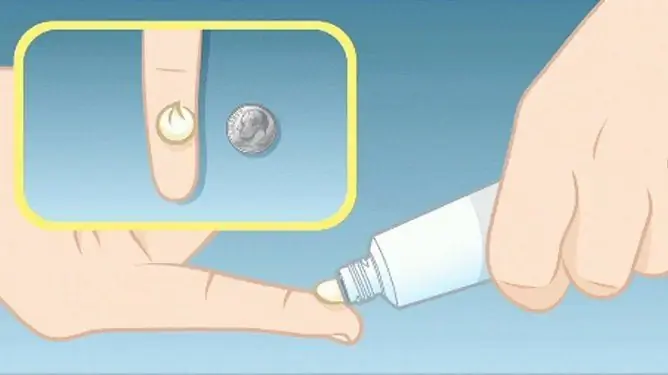- Author Rachel Wainwright [email protected].
- Public 2024-01-15 19:51.
- Last modified 2025-11-02 20:14.
Removal of warts with liquid nitrogen
The content of the article:
- The essence of the technique
- Indications and contraindications
- How to cauterize a wart with liquid nitrogen
- Consequences of the procedure
- Moxibustion of warts with liquid nitrogen: advantages and disadvantages
- Is it possible to completely cure pathology with liquid nitrogen
- Warts: a brief description
- Video
A wart is a benign neoplasm that can be localized anywhere on the skin. For treatment, destructive methods are often used - the formation can be burned out with a laser and electric current, excised with a scalpel, using cryodestruction or cryomassage (for flat formations). Removing warts with liquid nitrogen is one of the most effective methods that can be used to treat both an adult and a child. Before carrying out the procedure, you should consult a dermatologist.

Removal of warts with liquid nitrogen is painless and practically without complications
The essence of the technique
In cryodestruction, the formation is removed using liquid nitrogen. Under normal conditions, nitrogen is a colorless, odorless gas. At a temperature of -196 ° C, nitrogen passes from a gaseous state to a liquid, and it is in this form that it is used for medical procedures.
Under the influence of liquid nitrogen, tissues are frozen.
Indications and contraindications
Cryodestruction is a universal method of treatment that can be used to remove all kinds of benign formations.
In what cases is cryodestruction indicated:
- benign neoplasms of any localization;
- small size - up to 1 cm;
- often injured;
- with a complicated or uncomplicated course.
Thus, cryodestruction can be used to treat almost all papillomas, condylomas and warts. Cryotherapy has some limitations to its use - large formations are not removed with the help of liquid nitrogen.
It is contraindicated to carry out the procedure under the following conditions:
- cardiovascular pathology (hypertension);
- epilepsy;
- angiospasm;
- exacerbation of somatic diseases;
- pustular processes on the skin;
- acute infectious diseases (including colds).
How to cauterize a wart with liquid nitrogen
Cryodestruction can be performed using a special instrument (cryoprobe) or a cotton swab. The manual method is used more often:
- a cotton swab is dipped into a vessel with liquid nitrogen;
- applied to the wart, lightly pressed;
- the exposure time depends on the size of the neoplasm (from 3 to 30 seconds).
After this, the formation turns pale and becomes more dense. This is a sign that the procedure was successful. A slight tingling sensation may occur at this point.
Consequences of the procedure
The next day after the procedure, a bubble should appear on the skin. This is a normal body reaction that indicates tissue damage. The size of the bubble usually corresponds to the size of the growth, inside it is filled with a clear or reddish liquid. After 5-7 days after the appearance, the bubble should open.
Proper care allows the patient to facilitate the course of this period. What recommendations should be followed at home:
- do not pierce the bladder, this lengthens the healing process and can lead to infection;
- a gauze bandage can be applied to the bladder to avoid injury;
- if pain occurs, you can take Ibuprofen or Ketanov tablets;
- after opening the bladder, you need to treat the lesion site with an antiseptic solution 2 times a day.
After opening the bladder, a crust forms in its place, which disappears on its own after a week.
Moxibustion of warts with liquid nitrogen: advantages and disadvantages
Cryodestruction is a popular method of treating pathology. The widespread use of the method and positive reviews are associated with a number of advantages:
- Painlessness. Unlike most other methods, removal of the formation with liquid nitrogen does not cause pain, so the treatment is carried out without pain relief.
- Simplicity - there is no need for preparation for the procedure, as well as special postoperative care.
- Safety and absence of complications (bleeding, damage to surrounding tissues), the procedure can be performed even for children.
- Absence of a noticeable scar after removal of the formation.
It is also a relatively inexpensive treatment. The cost of 1 session in different clinics ranges from 400 to 1200 rubles.
There are several disadvantages as well. The main disadvantage is that several sessions are often required to achieve the result. If the formation has not been completely removed, repeated cryodestruction is prescribed 3 weeks after the first session. Another relative disadvantage is that after cryodestruction it is impossible to conduct a histological examination.
Is it possible to completely cure pathology with liquid nitrogen
Cryotherapy is just one of the methods for removing pathological formations. Given the viral nature of the disease, local treatment may not be sufficient and the growth will form again in the same or a different place. In this case, local or systemic antiviral treatment is used, which is aimed at combating the cause of the disease. Also, during the period of treatment, it is important to follow the general recommendations: eat right, avoid contact with a possible source of infection and hypothermia, and seek medical help in a timely manner.
Warts: a brief description
Warts are pathological formations of the skin that can appear in different places:
- face;
- torso;
- genitals;
- fingers and toes;
- plantar and dorsum of the foot.
The cause of the formation of warts is a viral infection (human papillomavirus, HPV).
There are several types of pathology:
| View | Characteristic |
| Ordinary (vulgar) | Localized mainly on the hands (fingers, back of the hand). They look like nodules 0.5-1 cm in size with a rough surface, rise above the skin. |
| Flat (youth) | They occur mainly in children. Formations practically do not rise above the skin, often multiple. |
| Genital warts | In the photo, they look like small pink nodules. The typical localization of such formations is the genitals. |
Video
We offer for viewing a video on the topic of the article.

Anna Kozlova Medical journalist About the author
Education: Rostov State Medical University, specialty "General Medicine".
Found a mistake in the text? Select it and press Ctrl + Enter.






